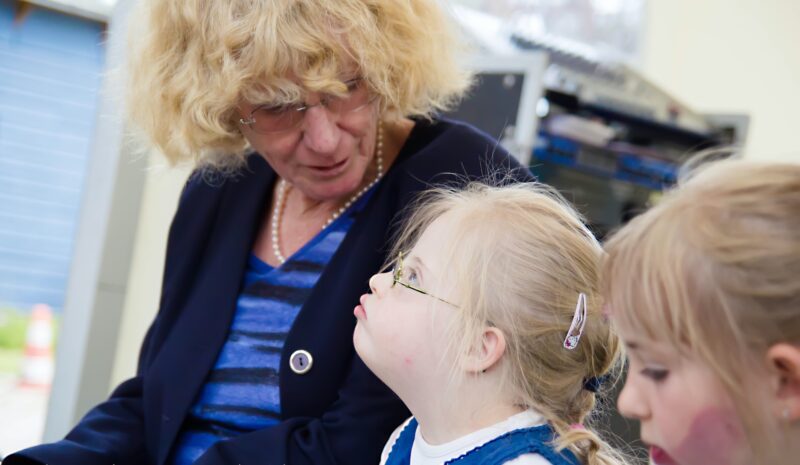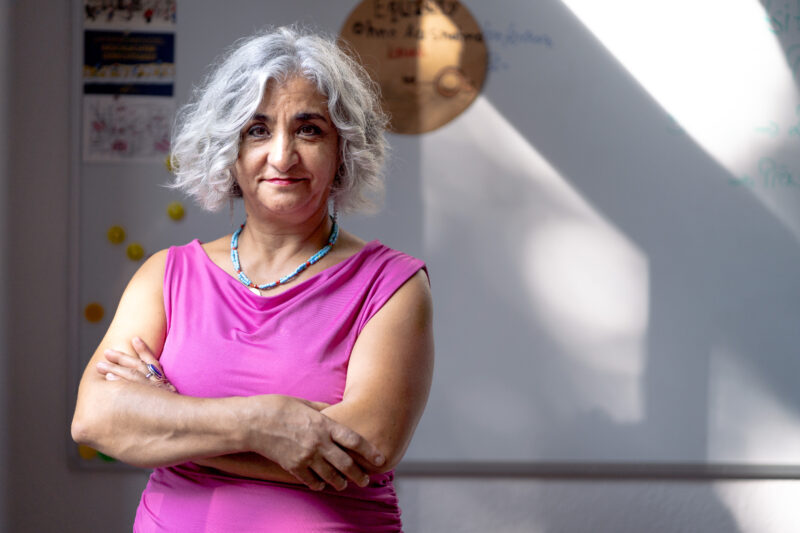So-called NFC chips are found in cash cards and smartphones. NFC stands for “near field communication”. Kim Egger, a 25-year-old from Hamburg, had two of these chips implanted under her skin. We met this extraordinary woman.
By Anne Klesse, Hamburg
Kim Egger stands at the checkout at the end of the goods conveyor belt and stows her purchases in her bag. The supermarket employee taps on his touchpad, the cash register display shows the amount that has to be paid. He asks: “Card or cash? ” Egger pushes up the right sleeve of her jacket and holds her forearm up to the reader. A short beep from the cash register and then a quiet rattling of the printer. Egger takes the shopping receipt and says goodbye.
Since autumn 2020, the 25-year-old has had a chip between her wrist and elbow with which she can pay in a similar way to a credit card. Theoretically, at least – she currently has no credit loaded on it, because she currently can’t get close enough to the reader with her arm due to the Corona protection shields at most cash registers.
“I am Robot”, a German provider of such NFC chips, points out on its website, that – for the setup – the implant can simply be held up to the smartphone and then managed, charged and also cancelled with an app. That is how transactions are synchronised. The chip works like the ones in prepaid cards and is topped up via direct online transfer. In the webshop, an NFC implant like this costs between 160 and 350 Euro, depending on the configuration.
Self-experiment for the Bachelor thesis
When Egger touches the spot where her chip sits under the skin, she can feel the edges of the biopolymer part, which measures about 2.6 by 1.6 centimetres. Since she got the first implant, Egger has acquired another chip: a pen the size of a grain of rice on her left hand between her index finger and thumb, which has stored her mobile phone number and that lights up red when it communicates with a corresponding reader or mobile phone.
In 2020, for her Bachelor’s thesis in Marketing and Digital Media at the FOM University Centre in Hamburg, she focused on the topic of NFC, the so-called”Near Field Communication”, an international transmission standard for the wireless exchange of data over short distances of up to 20 centimetres. The technology behind it is called RFID or “Radio Frequency Identification”.

It has been around since the 1970s, transmits data via electromagnetic induction and is mainly used for micropayments, i.e. contactless payment of small amounts. NFC chips are used, for example, in labels in the retail trade or in EC cards, which no longer have to be inserted into a reader for payments, but simply held close to it. Smartphone functions such as Apple Pay also work via NFC or ticketing systems in public transport; dogs have been registered with it for a long time.
With similar chips under the skin, doors could be opened or password-protected computers unlocked – the possible applications are manifold. However, this is still a pipe dream for the masses in this country. In order to not only theoretically deal with the question of the “acceptance of NFC hand implants in payment transactions” for her thesis, Egger decided to conduct a self-experiment. Her reviewing professor was immediately “enthused by the topic”.
Live chipping at events
A year and a half earlier, she had heard about it for the first time at a lecture by Patrick Kramer. The founder of the Hamburg-based company “Digiwell” – whose motto is “Build a better you” – had spoken about his visions in the field of “biohacking” and how supposed weak points in the human body could be optimised using digital technology. He mentioned that he himself wore several microchips in his body on which he had stored medical data, among other things.
Kramer has chipped volunteers live on stage at events such as the Cebit in the past, and he has been promoting this type of biohacking for more than a decade. Experts estimate that only a few thousand people in Germany have been “chipped” so far. In other countries, the digital transformation of humans is already more popular. In Sweden, for example, employees of the Tui subsidiary Nordic have been wearing a microchip in their hand for some time and use it to operate locker locks, doors and snack machines.

At the event she attended in Germany, Egger watched as someone in the audience had such an implant placed under the skin. She was fascinated and did more research afterwards: “The topic hasn’t let me go since.“ Finally, she found a bodymodder in Düsseldorf – that’s what people call themselves who change bodies with piercings, tattoos, jewellery scars or implants.
While he usually models horns on his clients’ foreheads or splits their tongues, he implanted Egger with the memory chip she had previously bought online. “It was not without its difficulties, the procedure was painful,” she recalls. She still had a large bruise on her arm for several weeks afterwards. A year later, a small pink scar is now visible.
In a survey for her Bachelor’s thesis in 2020, most of those she interviewed were open to the idea of carrying such a chip in the body, for example with emergency data. “That would be simple and practical,” Egger agrees. “Especially people with chronic diseases or pre-existing conditions could load vital data onto their implant, so that in an emergency, paramedics or doctors would have it immediately available via a reader.” However, in order to merely have the advantage of another payment method, most respondents rejected such an intervention.
In Germany, many have data protection concerns
Fear of complications, but also questions about data protection are people’s biggest fears. “In other countries, people are much more open about this topic,” Egger found out during her research. “In Germany, many are afraid that their data could be stolen or misused.” But this is unfounded, she says, because the chips can only be read if they are held very close to an appropriate reader. She herself has no concerns at all in this regard.
Her environment is a little less open. Her best friend was there when Egger paid with her forearm in a supermarket for the first time. “She found the idea of having a foreign object under the skin horrible,” recalls Egger, who works as a broadcasting assistant at NDR Radio after finishing her studies. “When my parents and my older brother found out about it, at first they thought I was a bit cuckoo. ” In the meantime, however, family and friends got used to the fact that she is so enthusiastic about the digital possibilities of biohacking.

On the second chip, she can theoretically store all kinds of data using a smartphone app, for example her business card or a social media profile. However, the storage space is quite small with 1,912 bytes of read and write memory – common USB sticks usually have storage capacities in the gigabyte range. So at the moment, all that is stored on the glass-sheathed “grain of rice” is her mobile phone number.
Egger thinks of a romantic cyborg encounter: “I imagine giving my mobile phone number via NFC to a man who approaches me in the club, I would find that very cool.” She laughs. The scene has some science fiction ring to it. Currently, the chips are mainly a “gimmick” for her. “But the more powerful they become, the more interesting the technology will be for more people,” she believes. Then dreams of the future will quickly become reality.











